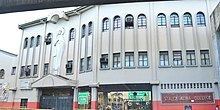Established 1706 Colors Black, White, Red Color Black, White, Red | Founded 1706 Headquarters Manila, Philippines | |
 | ||
Type Catholic school, Dominican President Sr. Annaliza Hipolito, OP Founder Francisca del Espíritu Santo Fuentes Motto Passion for Truth and Compassion for Humanity Similar PLM Graduate School of, University of the East Graduate, Asian Institute for Distance, Saint Rita College, Southeast Asian College | ||
Santa Catalina College is a private sectarian educational institution located in Sampaloc, Manila. It is being administered by the Congregation of the Dominican Sisters of St. Catherine of Siena, a congregation affiliated with the Dominican Order of the Roman Catholic Church.
Contents
History
The college traces its history back to the establishment of the congregation in the Philippines and its institution for Spanish religious women, the Beaterio (convent) de Sta. Catalina de Manila on July 26, 1696 in Intramuros under the leadership of Mother Francisca del Espiritu Santo, who served as the first prioress of the congregation in the country and Rev. Fr. Juan de Sto. Domingo, who served as the congregation's adviser.
The congregation soon began accepting native girls as well, in contrast to the other religious congregations at the time which only accepted Spanish women. At the same time, it was also beginning to be involved in the ministry of educating young women. Thus in 1706, the congregation established the Colegio de Santa Catalina, transforming the beaterio into a convent and a center of learning for women, both Spanish and Filipina women. Santa Catalina was the first educational institution run by religious women; it taught women the principles of Catholic faith and Christian living, as well as training on creative and domestic arts. The school was eventually placed under a royal patronage on February 17, 1716.
In 1863, the school was authorized to offer teacher training courses. In 1889, it was granted the privilege to confer the academic degree of Maestra Normal by royal decree. Despite damage due to the earthquakes of 1863 and 1880, the school's buildings were rebuilt in 1883; one of them underwent expansion in 1894. In addition, a 3-storey school building was constructed in 1939 under the supervision of the engineering firm Pedro Siochi and Company.
The school campus was destroyed in 1941 by Japanese bombs; the tertiaries were forced to move the school to Legarda St. and the tertiaries’ convent to Sampaloc. Colegio de Santa Catalina was not rebuilt in its old Intramuros site after the war and Colegio de San Juan de Letran later acquired the property for the expansion of its campus.
The congregation proceeded to reopen Santa Catalina College in its new home along Legarda St. after the war with the construction of its present school building in 1951. The college started the offering a secretarial course n 1953, Bachelor of Science in Elementary Education (BSEEd) and Bachelor of Science in Commerce (BSC) in 1965. With the rapid increase of colleges and universities in the area, the college enrollment started to decline while the grade school and high school departments continued to progress. During the school year 1979-1980, the college department was temporarily phased out and was re-opened in 1985 with the new course offerings:
